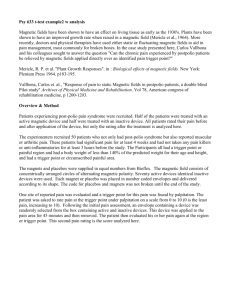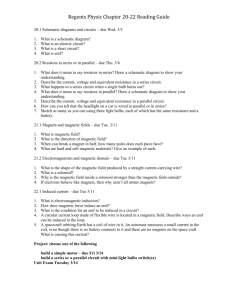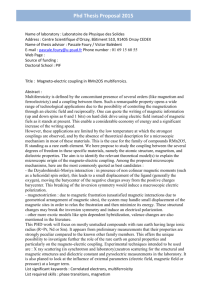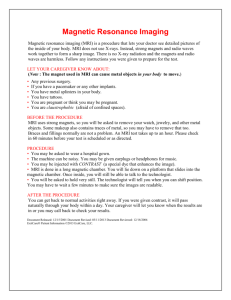final1-1-final-publishable-summary-ver2-0
advertisement
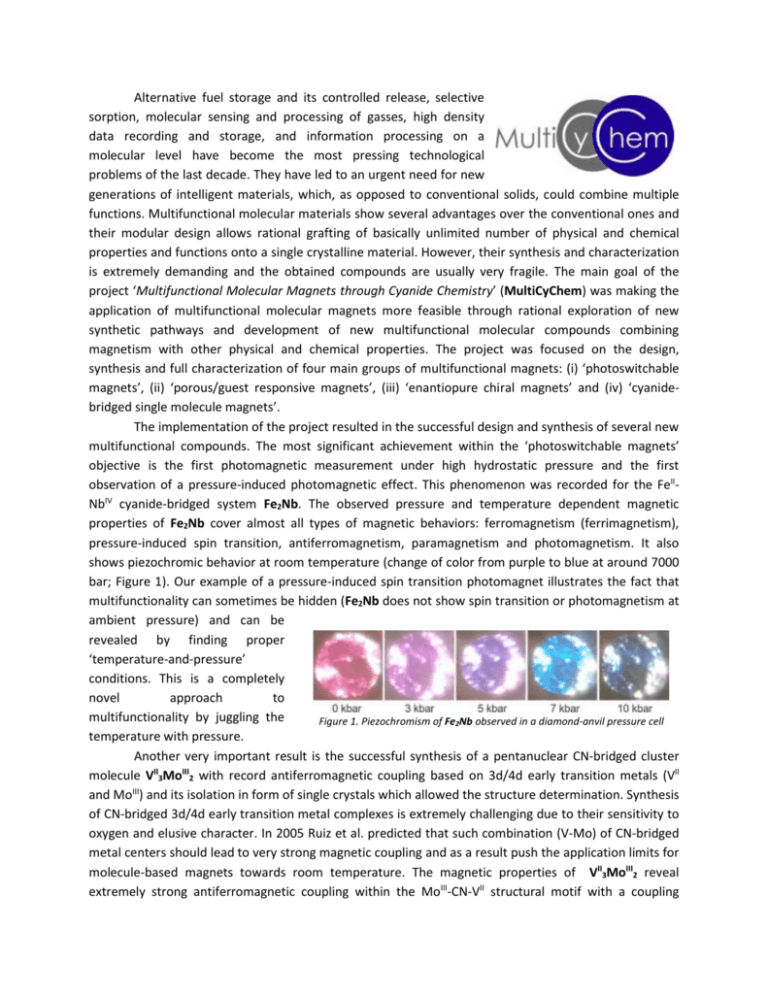
Alternative fuel storage and its controlled release, selective sorption, molecular sensing and processing of gasses, high density data recording and storage, and information processing on a molecular level have become the most pressing technological problems of the last decade. They have led to an urgent need for new generations of intelligent materials, which, as opposed to conventional solids, could combine multiple functions. Multifunctional molecular materials show several advantages over the conventional ones and their modular design allows rational grafting of basically unlimited number of physical and chemical properties and functions onto a single crystalline material. However, their synthesis and characterization is extremely demanding and the obtained compounds are usually very fragile. The main goal of the project ‘Multifunctional Molecular Magnets through Cyanide Chemistry’ (MultiCyChem) was making the application of multifunctional molecular magnets more feasible through rational exploration of new synthetic pathways and development of new multifunctional molecular compounds combining magnetism with other physical and chemical properties. The project was focused on the design, synthesis and full characterization of four main groups of multifunctional magnets: (i) ‘photoswitchable magnets’, (ii) ‘porous/guest responsive magnets’, (iii) ‘enantiopure chiral magnets’ and (iv) ‘cyanidebridged single molecule magnets’. The implementation of the project resulted in the successful design and synthesis of several new multifunctional compounds. The most significant achievement within the ‘photoswitchable magnets’ objective is the first photomagnetic measurement under high hydrostatic pressure and the first observation of a pressure-induced photomagnetic effect. This phenomenon was recorded for the FeIINbIV cyanide-bridged system Fe2Nb. The observed pressure and temperature dependent magnetic properties of Fe2Nb cover almost all types of magnetic behaviors: ferromagnetism (ferrimagnetism), pressure-induced spin transition, antiferromagnetism, paramagnetism and photomagnetism. It also shows piezochromic behavior at room temperature (change of color from purple to blue at around 7000 bar; Figure 1). Our example of a pressure-induced spin transition photomagnet illustrates the fact that multifunctionality can sometimes be hidden (Fe2Nb does not show spin transition or photomagnetism at ambient pressure) and can be revealed by finding proper ‘temperature-and-pressure’ conditions. This is a completely novel approach to multifunctionality by juggling the Figure 1. Piezochromism of Fe2Nb observed in a diamond-anvil pressure cell temperature with pressure. Another very important result is the successful synthesis of a pentanuclear CN-bridged cluster molecule VII3MoIII2 with record antiferromagnetic coupling based on 3d/4d early transition metals (VII and MoIII) and its isolation in form of single crystals which allowed the structure determination. Synthesis of CN-bridged 3d/4d early transition metal complexes is extremely challenging due to their sensitivity to oxygen and elusive character. In 2005 Ruiz et al. predicted that such combination (V-Mo) of CN-bridged metal centers should lead to very strong magnetic coupling and as a result push the application limits for molecule-based magnets towards room temperature. The magnetic properties of VII3MoIII2 reveal extremely strong antiferromagnetic coupling within the MoIII-CN-VII structural motif with a coupling constant estimated to be -114 cm-1, which is the strongest magnetic coupling ever reported for a heterobimetallic cyanide compound. This result will stimulate research efforts towards early transition cyanide complexes and will lead to the successful development of multifunctional molecules operating at room temperature. Within the objectives ‘porous/guest responsive magnets’ and ‘cyano-bridged single molecule magnets’ a series of new bimetallic trinuclear molecules MnIII2MIII based on hexacyanometallates [MIII(CN)6]3- (M = Co, Fe, Ru and Os) have been synthesized, characterized structurally and magnetically. It was found that the cyano-bridged MnIII2FeIII, MnIII2RuIII, MnIII2OsIII and the MnIII2CoIII/OsIII compounds are switchable quantum nanomagnets (or Single Molecule Magnets; SMM) and show switchable exchangebias behavior depending on methanol content. This is the first complete structural and magnetic study involving all haxacyanometallates(III) from group eight of the periodic table including the elusive hexacyanoruthenate(III) and hexacyanoosmate(III). To summarize, these results lend further credibility to the fact that SMM characteristics can be significantly improved by the use of heavy d-block metal centers with unquenched orbital angular momentum and strong spin-orbit coupling that lead to anisotropic magnetic exchange interactions. Moreover, the SMM behavior can be manipulated by finetuning the ligand properties vis-à-vis their ability to direct self-association of individual molecules, an important issue for the possible application of SMMs in devices. Following the strategy drafted in the objective no. (iii) ‘enantiopure chiral magnets’ three new compounds combining natural optical activity and magnetic ordering (magnetic optical activity) have been isolated by the successful incorporation of a chiral amine 1,2-diaminopropane into the MnII-NbIV cyano-bridged framework (in three forms: racemic, R and S). The compounds exhibit three-dimensional polymeric structure with magnetic ordering at 18 or 23 K depending on their hydration level. This makes the R- and S-forms the first examples of chiral magnetic sponges. As expected, they also exhibit interesting second-order optical properties i.e. Second Harmonic Generation (SHG) which was measured in collaboration with Prof. Shin-ichi Ohkoshi (Tokyo University). Moreover, the detailed MCD study (Magnetic Circular Dichroism) shows that MCD spectra are strongly and directly correlated with the magnetic ordering functionality. Due to the combination of three functionalities: magnetic ordering, reversible sorption and chirality, it is a rare example of a truly multifunctional molecular magnet. Additionally, several other significant results have been obtained: (1) a new photomagnetic building block Mo-Pt-Mo responsive to blue light with the photo-induced phase relaxing only at higher temperatures close to room temperature (very promising from the application point of view); (2) a series of photochromic lanthanide complexes Ln-dae showing quantum nanomagnetism (slow magnetic relaxation) combined with photo-switching of the ligand; (3) a family of previously unknown hexanuclear magnetic clusters M4Nb2 (M = MnII, FeII, CoII) based on octacyanoniobate(IV) showing very exciting type of chirality and different functionalities depending on the type of the transition metal used: photomagnetism (Fe4Nb2) and magneto-caloric effect (Mn4Nb2) that could be used for the construction of molecular photo-switches and molecular magneto-coolers, respectively; (4) a four-coordinate erbium(III) complex showing slow magnetic relaxation in the absence of the dc field with the impressive magnetization reversal energy barrier Ueff/kB = 66.4 K and magnetic hysteresis loop of the purely molecular origin up to 3.0 K; (5) a series of three new hard molecular magnets utilizing elusive airsensitive heptacyanomolybdate(III) with Curie temperatures at 31, 46 and 59 K, respectively; (6) an improved version of a Mn2Nb magnetic sponge with high critical temperature of 125 K and three-step magnetic ordering temperature switching depending on the hydration level; (7) a new bulky bridging ligand 4,7-tdapO2 with the ability to form stable organic radicals and its potassium salt as well as the first example of a coordination chain CuII-4,7-tdapO2; (8) a series of mononuclear four-coordinate 3d transition metal complexes (with MnII, FeII, CoII and NiII) exhibiting trigonal monopyramidal geometry and an open coordination site for CNcoordination with the CoII-analogue showing field-induced slow magnetic relaxation typical for Single Molecule Magnets; (9) the first example of a nonadecanuclear Co12Fe7 rosette molecule (Figure 2) with CN-bridges and 1,10Figure 2. Co12Fe7 rosette molecule tdapO2 decorating electroactive blocking ligands showing thermal charge transfer induced spin transition within the FeIII-CN-CoII structural motif. The results obtained within the MultiCyChem project have significantly advanced the knowledge of the multifunctional molecular materials and led to discoveries that will bring closer the long-desired real-world applications of these fascinating solids in nanotechnology and information technology (especially in ultra-high capacity data storage and ultra-fast data reading/writing). The main achievement ‘Pressure-induced spin crossover photomagnet’ bears features of a ground-breaking discovery that will strongly influence the communities of materials scientists, experimental physicists and molecular magnetism scientists. The future implementation of the project results will significantly contribute to the scientific excellence of the European research centers and particularly Jagiellonian University through a number of high quality, high impact scientific papers. The final phase of the project ‘Final data analysis and conceptualization’ took part in the European Research Area (ERA) and therefore, ERA is the main and direct beneficiary of the results. The project coordinator Prof. Barbara Sieklucka and the researcher Dr Dawid Pinkowicz are both faculty members at the Jagiellonian University Faculty of Chemistry in Kraków (Poland) and can be contacted via email: barbara.sieklucka@uj.edu.pl and dawid.pinkowicz@uj.edu.pl. Project website can be reached at http://www2.chemia.uj.edu.pl/znmm/mcchem-en.html.
